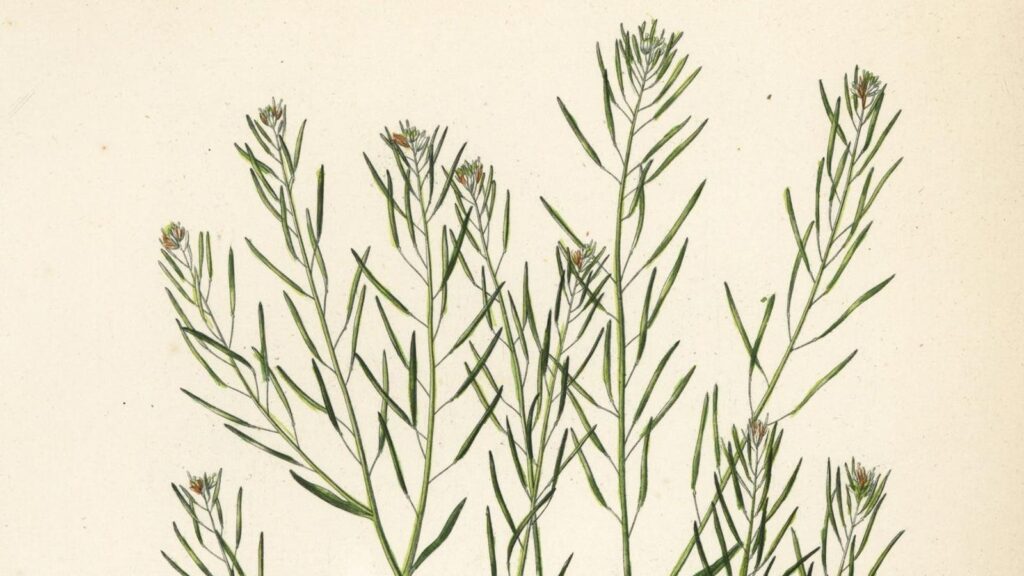
When we picture mathematics, we typically imagine calculators, computers, formulae, and abacuses. What almost no one on Earth imagines is a plant performing division in the dark. Yet, that is precisely what one unassuming species of weed has evolved to do. Arabidopsis thaliana, or the thale cress, is a tiny flowering plant that has all but rewritten our understanding of what living organisms are capable of.
This remarkable plant uses its nightly arithmetic to perfectly time a chemical ambush, showcasing a level of sophistication that has intrigued scientists worldwide.
How This Plant Does Division
At first glance, the thale cress is nothing special. It’s just a rosette of modest green leaves, easily overlooked. But once the sun dips below the horizon, an elegant biochemical computation begins inside its cells. As 2013 research from eLife explains, during the day, Arabidopsis gathers sunlight and converts it into starch, which serves as its energy reserve. As soon as night falls, the thale cress depends entirely on that stored starch to survive.
Instead of burning it at a constant rate, a random rate, or all at once, Arabidopsis performs a simple yet sophisticated calculation: it divides the total amount of starch it has stored by the number of hours left until dawn. In simpler terms: stored starch ÷ hours until expected dawn = nightly consumption rate. When necessary, it even accounts for exceptions. If the night comes early, for instance, the thale cress recalculates and slows its consumption so it doesn’t run out.
Why This Plant’s Counting Skills Matter
If the thale cress stored all its starch only to misuse it, it could face several problems that threaten its odds of survival. If Arabidopsis burns its reserves too fast, it risks starvation before dawn. Conversely, if it burns too slowly, leftover starch is wasted, which is a missed opportunity for growth. Mismanagement, in general, is likely to leave the cress vulnerable to either stress or damage.
By leveraging its ability to do real-time arithmetic, the thale cress ensures that its energy lasts exactly as long as it needs to. This precision is vital for efficient growth and long-term health.
How The Thale Cress Plant Times Its Chemical Attack
Most fascinatingly, Arabidopsis‘s talent for arithmetic isn’t just a means for conserving its energy. It’s also central to its defense strategy. Specifically, starch consumption isn’t the only biological process that it precalculates; it also preemptively ramps up the production of glucosinolates. These are potent chemical compounds that plants often use as a defense mechanism against predators, mostly insects.
As a 2019 study from Plant Physiology explains, Arabidopsis times the production of these defensive chemicals with mathematical precision. During the small hours of the night, as herbivores begin to stir or dawn approaches, the thale cress’s glucosinolate levels rise. Notably, it doesn’t produce these chemicals at a random rate; it’s synchronized to its internal clock and its starch budget, optimizing its defense machinery for the highest possible protection at the moment of greatest threat.
How Does A Brainless Plant Do Math?
Arabidopsis pulls off its nightly mathematics with a biochemical network, rather than neurons or a brain. Key elements of this network include:
- A circadian clock: Arabidopsis has an internal molecular timekeeper that tracks the approach of sunrise and sunset, much like humans. In essence, every single one of its cells “knows” the time of night.
- Starch sensors: It has chemical signals that detect exactly how much starch remains in its energy reserves.
- Specialized enzymes: The thale cress uses an enzyme called PWD to modify starch granules and regulate their breakdown.
The discovery of Arabidopsis‘s arithmetic skills has far-reaching implications. Understanding how plants manage their energy at night could prove invaluable to breeders who engineer crops for better survival in unpredictable light conditions or under stress. Similarly, the same principles could be repurposed in engineered microbes or cells to build biological timers or systems that “compute” with molecules.
Most importantly, this discovery implies that if plants can perform predictive calculations, the concept of intelligence likely isn’t only reserved for organisms with brains. Instead, it’s possible for anything that can process information and respond adaptively. This overhauls many of the long-held assumptions humans have biasedly put forward about what counts as “thinking.” Life, in its broad and inventive forms, often thinks in ways we haven’t learned to notice, let alone considered. Arabidopsis has simply given us the most surprising example yet: a plant that counts, calculates, defends itself, and ultimately survives with a single, rudimentary equation.





